Pompeii. Household shrines to the domestic gods, I.1.2 to I.5.3.
These pages contain all the references to Lararia, Aedicula, Niches, Sacrarium/Sacellum, and Lararium paintings, found inside properties in Pompeii.
For some of these the actual purpose is unknown.
The individual locations identified on each item may contain further photos and details, you can see these by looking at the pompeiiinpictures pages in question.
Back to household shrines list
I.1.2. Pompeii.
Painted lararium, no trace remains.

I.1.2 Pompeii. September 2018. Looking south-east across podiums in bar room. Photo courtesy of Aude Durand.
On the right (south) wall of the shop room, there used to be a painted lararium (now destroyed).
According to Boyce, the Genius with cornucopia on left, and patera on right was pouring a libation upon a round altar which stood to his right: to the left was a Lar holding rhyton and situla and still further to the left was a serpent: to the right the plaster had already fallen: across the top of the painting was a garland with the head of Medusa in the centre.
See Boyce G. K., 1937. Corpus of the Lararia of Pompeii. Rome: MAAR 14. (p.21)
According to Fiorelli on an opposite wall in the guise of a Penate, one saw the image of Bacchus supported on a column, with thyrsus, and perhaps a cup, with panther nearby.
See Pappalardo,
U., 2001. La Descrizione di Pompei per
Giuseppe Fiorelli (1875). Napoli: Massa Editore. (p.33).
See Fröhlich, T., 1991. Lararien und Fassadenbilder in den Vesuvstädten. Mainz: von Zabern, (p.249, L1).

I.1.2 Pompeii. ADS 1. Drawing by Geremia Discanno of three drawings from Reg. I.
Written beneath,
Top left – upper floor of a house facing the corridor of the theatre, Via Stabiana, (perhaps 1.2.6 or 1.2.10?).
Top right – second shop after the Stabian Gate, I.1.2, (Sogliano 161).
Below – second shop, as above. (Sogliano 19).
Now in Naples Archaeological Museum. Inventory number ADS 1.
Photo © ICCD. https://www.catalogo.beniculturali.it
Utilizzabili alle condizioni della licenza Attribuzione
- Non commerciale - Condividi allo stesso modo 2.5 Italia (CC BY-NC-SA 2.5 IT)
See Sogliano, A., 1879. Le pitture murali campane scoverte negli anni 1867-79. Napoli: Giannini. (p.38, no.161, and p.11, no.19).
According to Kuivalainen, describing the painting on the top right –
“On the left, a youth is standing with his weight on his right foot. He wears a violet himation over his back and across his left thigh; he leans with his left arm on a dark blue pillar. On the right stands (?) a panther with dark spots on yellowish fur, his hind legs and long tail visible, facing the figure. There seem to be rocks in the landscape.”
See Kuivalainen, I., 2021. The Portrayal of Pompeian Bacchus. Commentationes Humanarum Litterarum 140. Helsinki: Finnish Society of Sciences and Letters, (p.107, C1).
I.1.8 Pompeii.
Painted lararium, no trace remains.

I.1.8 Pompeii. September 2005. Entrance.
On the north (left) wall of the vestibule was formerly a lararium painting - now destroyed.
Beside a round altar stood the Genius, performing a sacrifice with the aid of tibicen and camillus, the latter of carrying a shallow dish in one hand.
The two Lares were on either side. Around the altar was a coiled serpent.
In the lower zone there were two other serpents, one on each side of a masonry projection above which was painted a pine cone.
Between these two serpents was the figure of a man pouring wine from an amphora into a dolium.
Above his head was written the name of Hermes [CIL IV 3355]. Presumably the name of the proprietor of the hospitium.
Opposite the painting, leaning against the south (right) wall, was a hearth for cooking.
Near to the hearth was the door that led to No.6.
See Boyce G. K., 1937. Corpus
of the Lararia of Pompeii. Rome:
MAAR 14. (p.21)
See Della Corte,
M., 1965. Case ed Abitanti di Pompei. Napoli: Fausto Fiorentino. (p.265)
See Fröhlich, T.,
1991. Lararien und Fassadenbilder in den Vesuvstädten. Mainz: von Zabern. (p.249, L2)
See Pappalardo, U., 2001. La Descrizione di Pompei per Giuseppe Fiorelli (1875). Napoli: Massa Editore. (p.33)
![I.1.8 Pompeii. 1872 drawing by Geremia Discanno of lararium painting.
Records from the 19th century excavations of this property described a painted shrine on the north wall of the ‘first room’.
It has been unclear which of the three street-side rooms of the property is the ‘first room’.
Only this sketch remains, which depicts an upper and lower register of decoration with various figures.
The lower register of the shrine’s decoration depicted a man carrying an amphora, ready to pour its contents into a dolium.
He was labelled HERMES and this is the reason the property has traditionally been named the Hospitium of Hermes. [CIL IV, 3355].
Flanking Hermes were two coiled serpents, rearing up toward an altar that was topped by a pinecone.
The upper register of the shrine’s decoration depicted a togate genius with cornucopia and patera next to a shrine with a snake coiled around it.
To the right of the genius was the camillus holding a patera and perhaps a rooster, and to the left of the genius and altar was a tibicen.
This scene was flanked by the twin Lares, and a garland or ribbon crowned the scene.
Nothing of the painted shrine survives.
Now in Naples Archaeological Museum. Inventory number ADS 2.
Photo © ICCD. http://www.catalogo.beniculturali.it
Utilizzabili alle condizioni della licenza Attribuzione - Non commerciale - Condividi allo stesso modo 2.5 Italia (CC BY-NC-SA 2.5 IT)](Pompeii%20Household%20Shrines%20p1_files/image005.jpg)
I.1.8 Pompeii. 1872 drawing by Geremia Discanno of lararium painting.
Records from the 19th century excavations of this property described a painted shrine on the north wall of the ‘first room’.
It has been unclear which of the three street-side rooms of the property is the ‘first room’.
Only this sketch remains, which depicts an upper and lower register of decoration with various figures.
The lower register of the shrine’s decoration depicted a man carrying an amphora, ready to pour its contents into a dolium.
He was labelled HERMES and this is the reason the property has traditionally been named the Hospitium of Hermes. [CIL IV, 3355].
Flanking Hermes were two coiled serpents, rearing up toward an altar that was topped by a pinecone.
The upper register of the shrine’s decoration depicted a togate genius with cornucopia and patera next to a shrine with a snake coiled around it.
To the right of the genius was the camillus holding a patera and perhaps a rooster, and to the left of the genius and altar was a tibicen.
This scene was flanked by the twin Lares, and a garland or ribbon crowned the scene.
Nothing of the painted shrine survives.
Now in Naples Archaeological Museum. Inventory number ADS 2.
Photo © ICCD. http://www.catalogo.beniculturali.it
Utilizzabili alle
condizioni della licenza Attribuzione - Non commerciale - Condividi
allo stesso modo 2.5 Italia (CC BY-NC-SA 2.5 IT)

I.1.8 Pompeii. September 2010. North wall of entrance room, with doorway leading to I.1.9.
In the 2011 excavations led by Stephen Ellis they were able to recognise the precise location of the lararium.
It would have been on the wall to the right of the doorway in this photograph.
This conclusion was based on the sketches themselves more than on the earliest written descriptions.
The altar appears in the sketch to have been three-dimensional, with a tile jutting out from the wall face upon which to place offerings.
Their analysis of the standing architecture revealed what may be the remnants of that tile.
On the southern face of the north wall in the entrance area, a heavily damaged tile projecting from the wall is preserved. On the top of this tile are traces of plaster, and mortar can be seen on its under-side – this served to level the tile within the uneven wall construction.
If this was indeed the same tile as shown in the sketches, then we are able to place the shrine to the east of the southern door from I.1.8 to I.1.9, and thus on the northern wall of the entrance courtyard of I.1.8.
Here it would have been visible from the street.
See www.fastionline.org/docs/FOLDER-it-2012-262.pdf
Photo courtesy of Drew Baker.
1.2.3 Pompeii.
Niche and painting on south wall of atrium.

I.2.3 Pompeii. October 2024. Looking east along south wall of atrium. Photo courtesy of Klaus Heese.
According to Boyce, on the south wall of the atrium was a rectangular niche.
On the wall below were two serpents and an altar, all done in white stucco relief upon a rectangular red panel.
There was also a painted figure of the Genius with cornucopia and patera. No traces remain.
In the same wall, to the right and higher, was a second niche.
This was smaller and had a vaulted ceiling.
Fiorelli referred to both these niches as lararia, but according to Boyce, this second niche served another purpose.
See Boyce G. K., 1937. Corpus of the Lararia of Pompeii. Rome: MAAR 14. (p.21 No.3 and Pl.9,2)
See Pappalardo,
U., 2001. La Descrizione di Pompei per
Giuseppe Fiorelli (1875). Napoli: Massa Editore. (p.34)
See Warscher, T.,
1925. Pompeji: Ein Führer durch die Ruinen.
Berlin und Leipzig: de Gruyter. (p.212, Abb.52)
See Garcia y
Garcia, L., 2006. Danni di guerra a
Pompei. Rome: L’Erma di Bretschneider. (p.38, Fig 20)
See Giacobello, F., 2008. Larari Pompeiani: Iconografia e culto dei Lari in ambito domestico. Milano: LED Edizioni, (p.132, no.1)

Niche on south wall of atrium, at east end. Photo courtesy of Klaus Heese.

I.2.3 Pompeii. October 2024.
Niche on south wall of atrium, at west end. Photo courtesy of Klaus Heese.

I.2.3 Pompeii. 1935 photo by Tatiana Warscher.
Looking towards the south wall of the atrium, with a single table-leg in the centre.
In the south wall are a cupboard/recess and two niches for the household Lares, underneath can be seen the two serpents coiling around an altar, in stucco relief.
Warscher described the atrium as –
“I.2.3, l’atrio con un monopodio in mezzo.
Nella parete sud – sono un armadio e due nicchie
per i Lari, sotto una delle quali sono effigiati in stucco a rilievo i due
serpenti.
See Warscher T., 1935. Codex Topographicus Pompeianus: Regio I.2. (no.2), Rome: DAIR, whose copyright it remains.
According to Boyce, on the south wall of the atrium was a rectangular niche.
(This can be seen on the left at the side of the wooden beam wall-support).
On the wall below were two serpents and an altar, all done in white stucco relief upon a rectangular red panel.
There was also a painted figure of the Genius with cornucopia and patera. No traces remain.
In the same wall, to the right and higher, was a second niche.
(This can be seen in the centre of the photo, behind the other wooden beam wall-support).
This was smaller and had a vaulted ceiling.
Fiorelli referred to both these niches as lararia, but according to Boyce, this second niche served another purpose.
See Boyce G. K., 1937. Corpus of the Lararia of Pompeii. Rome: MAAR 14. (p.21 No.3 and Pl.9,2)
See Pappalardo,
U., 2001. La Descrizione di Pompei per
Giuseppe Fiorelli (1875). Napoli: Massa Editore. (p.34)
See Warscher, T.,
1925. Pompeji: Ein Führer durch die
Ruinen. Berlin und Leipzig: de Gruyter. (p.212, Abb.52)
See Giacobello,
F., 2008. Larari Pompeiani: Iconografia e culto dei Lari in ambito
domestico. Milano: LED Edizioni, (p.132, no.1)
See Garcia y
Garcia, L., 2006. Danni di guerra a
Pompei. Rome: L’Erma di Bretschneider. (p.38, Fig 20)

I.2.3 Pompeii. 1912 photo by Tatiana Warscher. Lararium in the south wall of the atrium.
Warscher noted that the photo was taken by her in 1912 (on her honeymoon!).
When writing the DAIR copy of the Codex (1935) she wrote –
“Adesso i
serpenti sono in uno stato peggiore. Il Genio familiare con patera e cornucopia
non esisteva già nell’anno 1912”.
(translation: “Now the serpents are in a bad state. The Genius with plate and cornucopia did not exist even by 1912”.)
See Warscher T., 1935. Codex Topographicus Pompeianus: Regio I.2. (no.3), Rome: DAIR, whose copyright it remains.
Sacrarium on the south side of the Viridarium – no traces remain.

I.2.3 Pompeii. December 2006. Looking across the garden area, towards the remains of the two rooms in the south-east corner.
According to Fiorelli, on the opposite side of the garden from the vestibule and bedroom, there was a storeroom and a room uniquely used for the sacred domestic Gods (Sacrarium).
A brick altar was in the middle, on which was painted a cockerel.
The image of the Genius was painted on the wall pouring a libation onto the altar.
Nearby was a large serpent, plants, and it was surmounted by garlands with small birds.
See Pappalardo, U., 2001. La Descrizione di Pompei per Giuseppe Fiorelli (1875). Napoli: Massa Editore. (p.34).

1.2.3 Pompeii. September 2010.
Looking south into two small adjoining rooms, and remains of perimeter wall onto Vicolo del Conciapelle. Photo courtesy of Drew Baker.
According to Boyce, on the south side of the Viridarium were two small adjoining rooms.
One was a storeroom and the other, according to Fiorelli, was devoted only to the service of the domestic cult.
In the centre of the room entered from the first door stood a masonry altar, on which was painted a cockerel.
On the south wall a panel of white stucco was marked off with red stripes and within it was the Lararium painting.
The Genius poured a libation upon an altar, towards which a large serpent moved, moving through plants.
Across the top were three small festoons, on each of which perched a little bird.
See Boyce G. K., 1937. Corpus of the Lararia of Pompeii. Rome: MAAR 14. (p.21 No.4)

1.2.3 Pompeii. September 2010. East wall of room, possibly sacrarium. Photo courtesy of Drew Baker.
1.2.6 Pompeii.
Kitchen area, lararium niche with painting.

1.2.6 Pompeii. October 2024. Steps to upper floor and kitchen. Photo courtesy of Klaus Heese.
On the right is the arched niche in the north wall of the kitchen on the upper floor.

1.2.6 Pompeii. September 2010. Looking north to steps to upper floor, from north portico.
On the right is the arched niche in the north wall of the kitchen on the upper floor. Photo courtesy of Drew Baker.
According to Boyce –
“In a small room, perhaps a kitchen on the intermediate floor, reached by stairs on north side of peristyle, was a Lararium.
Below a small arched niche, a rectangular panel was marked off and within it was painted a single serpent advancing left towards the offerings upon an altar: in the background were plants and across the top were festoons.”
See Boyce G. K., 1937. Corpus of the Lararia of Pompeii. Rome: MAAR 14. (p.21 no.5).
Note: Found in the kitchen located on the first floor was a
bronze statuette of Diana with bow and quiver. Giornale degli Scavi, N.S. III, 1874, 58.
See Giacobello, F., 2008. Larari Pompeiani: Iconografia e culto dei Lari in ambito domestico. Milano: LED Edizioni, (p.132, no.3)

1.2.6 Pompeii. September 2010. Detail of niche on upper floor north wall.
This can be seen on the east (right) of the steps and would have been in the north wall of the upper room. Photo courtesy of Drew Baker.
1.2.8 Pompeii.
Niche on north wall of bar-room.

I.2.8 Pompeii. 1961. Looking east from Via Stabiana. Photo by Stanley A. Jashemski.
Source: The Wilhelmina and Stanley A. Jashemski archive in the University of Maryland Library, Special Collections (See collection page) and made available under the Creative Commons Attribution-Non-Commercial License v.4. See Licence and use details.
J61f0747

I.2.8 Pompeii. October 2024. Looking north across counters towards niche in north wall. Photo courtesy of Klaus Heese.

North wall with niche behind additional counter with three urns, and L-shaped serving counter at the front. Photo courtesy of Klaus Heese.
I.2.10 Pompeii.
Niche/pseudo-aedicula lararium, north wall of garden area.

I.2.10 Pompeii. September 2010. Looking north across peristyle area.
The peristyle was badly damaged during the bombing in September 1943.
The remains of the summer biclinium can be seen against the north wall.
In the north wall, on the left, is the square niche. Photo courtesy of Drew Baker.

I.2.10 Pompeii. December 2006.
On the left, the north-east corner of the triclinium (with remains of east wall with window just visible).
In the centre, and on right, north wall of garden area with niche and remains of roughly executed aedicula façade.
The niche would have been situated above the north couch of the biclinium.
See Boyce G. K., 1937. Corpus of the Lararia of Pompeii. Rome: MAAR 14, (p.22, no.6)
Giacobello described this as a pseudo-aedicula lararium, from north wall of garden area.
See Giacobello, F., 2008. Larari Pompeiani: Iconografia e culto dei Lari in ambito domestico. Milano: LED Edizioni, (p.252, no.V1)
I.2.12/13 Pompeii.
Lararium painting on south wall of the bar, no trace remains.

I.2.13 Pompeii. May 2005. Entrance doorway, looking east.
On the right of the entrance doorway would have been the site of the south wall of the bar.
This wall was destroyed in the 1943 bombing together with a niche or recess in the south wall.
According to Boyce, on a wall was a lararium painting but only the lower parts of two figures (one a Lar) remained.
Two serpents confronted at an altar with offerings.
See Boyce G. K., 1937. Corpus of the Lararia of Pompeii. Rome: MAAR 14. (p.22, no.7)
According to Sogliano, the sacred picture was destroyed (by 1879).
See Sogliano, A., 1879. Le pitture murali campane scoverte negli anni 1867-79. Napoli: (p.19, no.65)

I.2.13 Pompeii. September 2005. Taken from rear.
Looking west towards site of ruined small rear room or cupboard, and bar-room onto Via Stabiana and the Little Theatre.
On the left, behind the brick pilaster separating two doorways, would have been the site of the south wall of I.2.13.
I.2.14 is visible on the extreme right of the picture.
1.2.16 Pompeii.
Masonry aedicula, with an arched niche, built on top of a solid podium South end of west wall of north portico.

1.2.16 Pompeii. September 2010.
Room 6, garden area. Looking north towards northern end of garden and north portico. Photo courtesy of Drew Baker.

1.2.16 Pompeii. September 2010. Niche in north-west corner of garden. Photo courtesy of Drew Baker.
According to Boyce –
In the north-west corner of the pseudo-peristyle stood a masonry aedicula, consisting of an arched niche (h.0.50, w.0.38, d.0.28) built on top of a solid podium (0.50 square h. about 0.90) – all now in a ruinous state.
See Boyce G. K., 1937. Corpus
of the Lararia of Pompeii. Rome:
MAAR 14, (p.22, no.8)
See Giacobello,
F., 2008. Larari Pompeiani: Iconografia e culto dei Lari in ambito
domestico. Milano: LED Edizioni, (p.252, no.V2)
I.2.17 Pompeii.
Pseudo-aedicula lararium, east
wall of entrance corridor.

I.2.17 Pompeii. March 2009. Lararium niche of coloured marble, in east wall of fauces.
According to Boyce, the walls, projecting floor and aedicula façade of this rectangular niche are all of greyish marble.
In the floor were three holes for the bases of statuettes.
See Boyce G. K., 1937. Corpus
of the Lararia of Pompeii. Rome:
MAAR 14. (p.22 no.9, pl.7,2)
Giacobello described this as a pseudo-aedicula lararium, east wall of vestibule.
See Giacobello, F., 2008. Larari Pompeiani: Iconografia e culto dei Lari in ambito domestico. Milano: LED Edizioni, (p.230, no.F1)
I.2.17 Pompeii.
Shrine/aedicula found with statuette of Venus, east wall of garden area.

I.2.17 Pompeii. September 2010. Shrine/aedicula against east wall, looking east. Photo courtesy of Drew Baker.
According to Boyce, this may have been built as a lararium, or simple as a decorative aedicula (h.2.35, w.1.18, d.0.75).
See Boyce G. K., 1937. Corpus
of the Lararia of Pompeii. Rome:
MAAR 14. (p.22, no.10, pl.37,2)

Statuette of Venus from Room 13, east wall, found in March 1873.
Now in Naples Archaeological Museum. Inventory number 109608.
On display in
“L’altro MANN” exhibition, October 2023. Photo courtesy of Giuseppe Ciaramella.
According to Fiorelli –
“Found in a niche faced with marble, this standing statuette of Venus leaning against her idol, still keeping the colours in which it had been painted.”
See Pappalardo, U., 2001. La Descrizione di Pompei per Giuseppe Fiorelli (1875). Napoli: Massa Editore. (p.36).
1.2.18/19 Pompeii.
Rectangular niche in east wall of bar-room.


I.2.18 Pompeii. May 2003. East wall of bar. Photo courtesy of Nicolas Monteix.

I.2.18 Pompeii. March 2009. Recess in east wall.
According to Boyce, this was a rectangular niche (h.0.28, w.0.44, d.0.20, h. above floor 1.05). Its interior walls were painted red.
He quotes reference – Fiorelli, Descr., 44.
See Boyce G. K., 1937. Corpus of the Lararia of Pompeii. Rome: MAAR 14. (p.22, number 11A).
Arched niche in kitchen.

I.2.18/19 Pompeii. September 2010.
Looking south into small room in south-east corner. Latrine and kitchen? Photo courtesy of Drew Baker.
According to Fiorelli, the room with the latrine had a hollow in the wall for placing a lamp.
See Pappalardo, U., 2001. La Descrizione di Pompei per Giuseppe Fiorelli (1875). Napoli: Massa Editore. (p.36)
According to Boyce, in the south-west corner of the kitchen, built in a peculiar manner, was an arched niche.
(height 0.30m, w.0.30m, d.0.25m, height above the floor 1.30m).
See Boyce G. K.,
1937. Corpus of the Lararia of Pompeii.
Rome: MAAR 14. (p.22, no.12B).
I.2.20/21 Pompeii.
Painting with arched niche on north wall of garden area.

I.2.20 Pompeii. November 2024.
Looking towards north-west corner and masonry biclinium of garden area, with niche in north wall. Photo courtesy of Annette Haug.
According to Jashemski, the garden was excavated in 1873.
It had a roofed passageway on the east and the south.
In the north-west corner, there was a masonry biclinium with a round table.
There was a niche lararium on the north garden wall.
See Jashemski, W. F., 1993. The Gardens of Pompeii, Volume II: Appendices. New York: Caratzas. (p.24).


I.2.20 Pompeii. 1935 photo taken by Tatiana Warscher. Looking towards north wall of garden with niche.
Warscher noted
“La pittura del larario è svanita”.
(translation: The lararium painting had vanished).
See Warscher T., 1935. Codex Topographicus Pompeianus: Regio I.2. (no.35), Rome: DAIR, whose copyright it remains.

I.2.20 Pompeii. Painting of Bacchus and Fortuna found under the niche on the north wall of garden.
See Fiorelli, Descrizione
di Pompei, 1875, (p. 46).
According to Boyce,
On the north wall of the garden is a lararium painting (h.1.62 by w.230). (Boyce notes that “Sogliano gave the dimensions as height 2.30 by width 1.62, but it is clear from the drawing in Fiorelli that the width is of the greater dimension”.)
In the centre was a globe, attached to it was a crescent moon and above it, a star.
On the left stood Fortuna, holding a cornucopia in her left and a rudder in her right hand.
On the right was Bacchus, resting his left arm on a pilaster and holding a thyrsus.
With his right hand, he tips wine from a kantharos into the mouth of the panther standing at his side.
Across the top are two garlands.
Below a large crested serpent glides amidst plants towards an altar furnished with offerings – an egg and a pine cone.
In the wall beside the serpent is an arched niche (h.0.40, w.0.58, d.0.18, h. above floor 1.20) within which were found various objects.
See Boyce G. K., 1937. Corpus of the Lararia of Pompeii. Rome: MAAR 14. (p.22-23, no.13).
See Fröhlich, T., 1991. Lararien und Fassadenbilder in den Vesuvstädten. Mainz: von Zabern, (p.250, L3, abb.2)
“A young half-naked Bacchus is depicted in customary fashion.
He is in the company of Fortuna, as identified by her attributes, in a garden lararium.”
See Kuivalainen, I., 2021. The Portrayal of Pompeian Bacchus. Commentationes Humanarum Litterarum 140. Helsinki: Finnish Society of Sciences and Letters, (p.129-30, D7).

I.2.20 Pompeii. September 2018. Detail of niche set into north wall. Photo courtesy of Aude Durand.

I.2.20 Pompeii. Bust of Isis found in Caupona at I.2.20. Now in Naples Archaeological Museum.
According to Boyce, a terracotta bust of a woman with a modius upon her head and adorned with a necklace was found in the niche.
Also found in the niche, were:
A bronze equestrian statuette of a helmeted warrior, holding a spear in his right hand.
A bronze statuette of Diana, holding a bow in her left hand, she was drawing an arrow from the quiver on her shoulder with the right hand.
A terracotta statuette of a woman, fully clothed, seated and holding a child in swaddling clothes.
A terracotta object in the form of a kind of cradle, within which lies the half-bust of a child with a bulla about its neck.
A green-glazed clay head representing Medusa.
A marble Bacchic head from a herm.
See Boyce G. K., 1937. Corpus
of the Lararia of Pompeii. Rome:
MAAR 14. (p.23).
I.2.22 Pompeii.
Rectangular arched niche in north wall.


I.2.22 Pompeii. September 2010. North wall of shop. Photo courtesy of Drew Baker.

I.2.22 Pompeii. September 2018. Room 1, north wall with niche. Photo courtesy of Aude Durand.
According to Boyce –
In the room into which one enters directly from the street, in the north wall is an irregular rectangular niche (h.0.50, w.0.42, d.0.25, h. above floor 1.40) with peaked ceiling, its interior walls painted red.
See Boyce G. K., 1937. Corpus of the Lararia of Pompeii. Rome: MAAR 14. (p.23, no.14).

I.2.22 Pompeii. September 2018. Room 1, north wall with niche. Photo courtesy of Aude Durand.
I.2.23 Pompeii.
Arched niche in east wall of main room.


I.2.23 Pompeii. September 2010. East wall of entrance area, with niche. Photo courtesy of Drew Baker.
According to Garcia y Garcia, the dividing wall of a rustic room in this area was destroyed due to the 1943 bombing.
See Garcia y
Garcia, L., 2006. Danni di guerra a Pompei. Rome: L’Erma di Bretschneider. (p.37)

I.2.23 Pompeii. September 2018. East wall of entrance area, with niche. Photo courtesy of Aude Durand.


I.2.23 Pompeii. September 2010. Detail of niche on east wall. Photo courtesy of Drew Baker.
According to Boyce –
in the east wall of the main room was an arched niche (h.0.32, w.0.32, d.0.26, h. above floor 1.75).
See Boyce G. K., 1937. Corpus
of the Lararia of Pompeii. Rome:
MAAR 14. (p.23, no.15)
I.2.24 Pompeii.
Lararium painting and niche on south side of atrium.

I.2.24 Pompeii. September 2018. Looking south-west across atrium from large room on north side. Photo courtesy of Aude Durand.

I.2.24 Pompeii. 1935 photo taken by Tatiana Warscher.
Looking towards south wall of atrium, with niche and doorway to understairs area.
See Warscher T., 1935. Codex Topographicus Pompeianus: Regio I.2. (no.45), Rome: DAIR, whose copyright it remains.
According to Boyce, on the south side of the atrium was the lararium.
Above an arched niche (h.0.60, w.0.52, d.0.23, h. above floor 1.35) was painted a cylindrical altar (tripod according to Fiorelli) with a Genius pouring a libation.
Standing beside him was the tibicen and to the left was a Lar. The Lar on the right was not preserved.
Below the niche were the two serpents.
On the wall on each side of the niche was painted a large dog?
The one on the left was poorly preserved but was seen to be lying down, while the one on the right was opening his mouth wide.
From the hindquarters of this second dog there projected horizontally the upper half of the body of a man.
See Boyce G. K., 1937. Corpus of the Lararia of Pompeii. Rome: MAAR 14. (p.23, no.16 and Pl.2,2)
See Sogliano, A., 1879. Le pitture murali campane scoverte negli anni 1867-79. Napoli: Giannini. (p.17, no.46).

I.2.24 Pompeii. September 2018. Niche on south wall of atrium. Photo courtesy of Aude Durand.

I.2.24 Pompeii. September 2018.
Detail of niche (h.0.60, w.0.52, d.0.23, h. above floor 1.35) on south wall. Photo courtesy of Aude Durand.
Base and niche against east wall of peristyle, no trace remains (?).

I.2.24 Pompeii. October
2017. Looking towards the north and east walls of the peristyle.
Foto Taylor Lauritsen, ERC Grant 681269
DÉCOR.
According to Boyce –
In the east wall of the peristyle, above one
of the beds of a masonry triclinium, is a niche, described by Fiorelli as a sacrarium,
more fully by Mau as “un aedicula, una
base, cioè, con una piccola tavola, che sta in un specie di nicchia coperta a
volta, e probabilmente conteneva un idolo”.
There remains now only the solid base (0.40
by 0.32, h.0.65) and on the wall above it the marks left by a vaulted structure
which rested on the base.
He quotes references – Bull. Inst., 1874,
262; Fiorelli, Descr., 47.

I.2.24 Pompeii. September 2010.
Looking south across peristyle over remains of the triclinium, towards the three rooms on the south side.
On the left could be the remains of the altar base. Photo courtesy of Drew Baker.

I.2.24 Pompeii. 1935 photo taken by Tatiana Warscher.
Looking south across peristyle over remains of the triclinium, towards the rooms on the south side.
On the left, the altar base can be seen, (see description from Boyce, (p.23, no.17).
See Warscher T., 1935. Codex Topographicus Pompeianus: Regio I.2. (no. 46), Rome: DAIR, whose copyright it remains.
1.3.2 Pompeii.
Ruined niche in north wall.

I.3.2 Pompeii. September 2010. Looking towards the north wall. Photo courtesy of Drew Baker.
According to Boyce –
In the north wall is an arched niche (its condition too ruinous for measurement), its walls coated with white stucco.
See Boyce G. K., 1937. Corpus of the Lararia of Pompeii. Rome: MAAR 14. (p.23, no.18).

I.3.2 Pompeii. 1935 photograph by Tatiana Warscher.
Looking north along west side of the counter showing four embedded dolia, with Via Stabiana on the left.
The niche, as mentioned by Boyce above, can be seen in the north wall.
According to
Warscher, quoting Fiorelli – “I.3.2, Bottega con podio, in cui stanno
infisse quattro grandi urne di terracotta, avendo a destra una gradinata. Nel
muro nord si trovano i resti della nicchia dei penati”.
See Warscher, T, 1935: Codex Topographicus Pompejanus, Regio I, 3: (no. 3), Rome, DAIR, whose copyright it remains.
I.3.3 Pompeii.
Masonry base in north-west corner of atrium, probably base of an aedicula lararium.

I.3.3 Pompeii. May 2005. Looking out onto Via Stabiana from inside the atrium.
The doorway on the left leads into the entrance corridor, the doorway on the right connected to the shop at I.3.4.
The masonry base of the lararium, is on the right.

I.3.3 Pompeii. December 2007. North-west corner of atrium.
According to Boyce –
In the north-west corner of the atrium stood a structure
described by Fiorelli as “un ara de’ sacrifizi”, by Mau as “una
tavola di materiale”.
There remains today a large masonry podium (1.0 by 1.10, h. about 1.0) which looked like the base of an aedicula, according to Boyce.
See Boyce G. K., 1937. Corpus of the Lararia of Pompeii. Rome: MAAR 14. (p.24, no.19).

I.3.3 Pompeii. 1935 photograph by Tatiana Warscher. Looking towards the north-west corner of the atrium.
See Warscher, T, 1935: Codex Topographicus Pompejanus, Regio I, 3: (no. 5), Rome, DAIR, whose copyright it remains.
I.3.5 Pompeii.
Broad arched niche in east wall of rear room.

I.3.5 Pompeii. September 2010. Looking east from entrance. Photo courtesy of Drew Baker.
According to Fiorelli, in the middle of the entrance room was a podium or bench.
See Pappalardo, U., 2001. La Descrizione di Pompei per Giuseppe Fiorelli (1875). Napoli: Massa Editore. (p.38)

I.3.5 Pompeii. 1935 photograph taken by Tatiana Warscher. Looking east into rear vaulted room.
See Warscher, T, 1935: Codex Topographicus Pompejanus, Regio I, 3: (no.12), Rome, DAIR, whose copyright it remains.

According to Boyce –
In the rear room behind the entrance at No.5, in the east wall is a broad arched niche (h.0.57, w.1.07, d.0.25, h. above floor 1.25).
Its walls were coated with white stucco and adorned with flowers and plants, painted in red, blue and green.
Eventually, a layer of red stucco was spread over the top, and since peeling off, had revealed the earlier layer underneath.
See Boyce G. K., 1937. Corpus of the Lararia of Pompeii. Rome: MAAR 14. (p.24, no.20).

I.3.5 Pompeii. 1935 photograph taken by Tatiana Warscher.
She wrote -
“In the rear wall of the vaulted room, one found a vaulted lararium”.
See Warscher, T, 1935: Codex Topographicus Pompejanus, Regio I, 3: (no.13), Rome, DAIR, whose copyright it remains.

I.3.5 Pompeii. September 2010. Detail of niche showing remains of painted flowers and plants. Photo courtesy of Drew Baker.
1.3.8a Pompeii.
Niche, east wall of kitchen.


I.3.8a Pompeii. September 2010. Detail of niche on east wall. Photo courtesy of Drew Baker.
According to Boyce –
this rectangular niche (h.0.40, w.0.38, d.0.26, h. above floor 1.65) was to be found in the east wall of the kitchen, above the hearth.
Its walls were coated with successive layers of plaster.
See Boyce G. K.,
1937. Corpus of the Lararia of Pompeii.
Rome: MAAR 14. (p.24, no.21)
See Giacobello, F., 2008. Larari Pompeiani: Iconografia e culto dei Lari in ambito domestico. Milano: LED Edizioni, (p.133, no.4)
I.3.8b, Pompeii.
Niche, east wall of peristyle, no trace remains.

I.3.8b Pompeii. September 2010.
Looking east towards south-central doorway from east portico of peristyle, towards kitchen at rear. Photo courtesy of Drew Baker.
According to Boyce, somewhere along the east wall of the peristyle was a niche.
In the niche, a terracotta statuette of Minerva was found.
She was wearing a helmet and holding a shield on her left arm and holding a patera in her right hand.
See Boyce G. K.,
1937. Corpus of the Lararia of Pompeii.
Rome: MAAR 14. (p.24, no.22)
Giornali degli Scavi,
N.S. I, 1869, p. 301.
Boyce gave a note 1 on page 24, to this entry. It read –
In a room opening off the east side of the peristyle a bronze statuette of Fortuna was found.
She was holding a cornucopia against her left shoulder.
Giornali degli Scavi,
N.S., i, 1869, 305.
According to Giacobello – the niche is no longer conserved.
See Giacobello, F., 2008. Larari Pompeiani: Iconografia e culto dei Lari in ambito domestico. Milano: LED Edizioni, (p.252, no.V3)
Niches, north wall of kitchen.

I.3.8b Pompeii. December 2006. North-west corner of kitchen on east side, through hole in wall from I.3.25.
According to Boyce, two arched niches were found on the north wall of the kitchen.
The niches were 0.58 high and 0.36 wide, 0.30 deep and 1.10 above the floor.
The niches were side by side, and 0.60 apart.
He said Fiorelli described them as “nicchie per i domestici Lari”.
See Boyce G. K., 1937. Corpus
of the Lararia of Pompeii. Rome:
MAAR 14. (p. 24, no.23)
See Giacobello, F., 2008. Larari Pompeiani: Iconografia e culto dei Lari in ambito domestico. Milano: LED Edizioni, (p.134, no.5)

I.3.8b Pompeii. September 2010. North wall with niches. Photo courtesy of Drew Baker.
According to Fiorelli, “in the kitchen, other than the hearth, one finds two niches for the worship of the domestic gods”.
See Pappalardo, U., 2001. La Descrizione di Pompei per Giuseppe Fiorelli (1875). Napoli: Massa Editore. (p.39)

I.3.8b Pompeii. 1935 photograph taken by Tatiana Warscher described as –
Two niches for the household gods, from a rear room.
See Warscher, T, 1935: Codex Topographicus Pompejanus, Regio I, 3: (no.25a), Rome, DAIR, whose copyright it remains.
I.3.15 Pompeii.
Arched niche in west wall.

I.3.15 Pompeii.
Photographed 1970-79 by Günther Einhorn, picture courtesy of his son Ralf Einhorn. Looking towards niche in west wall, on right.
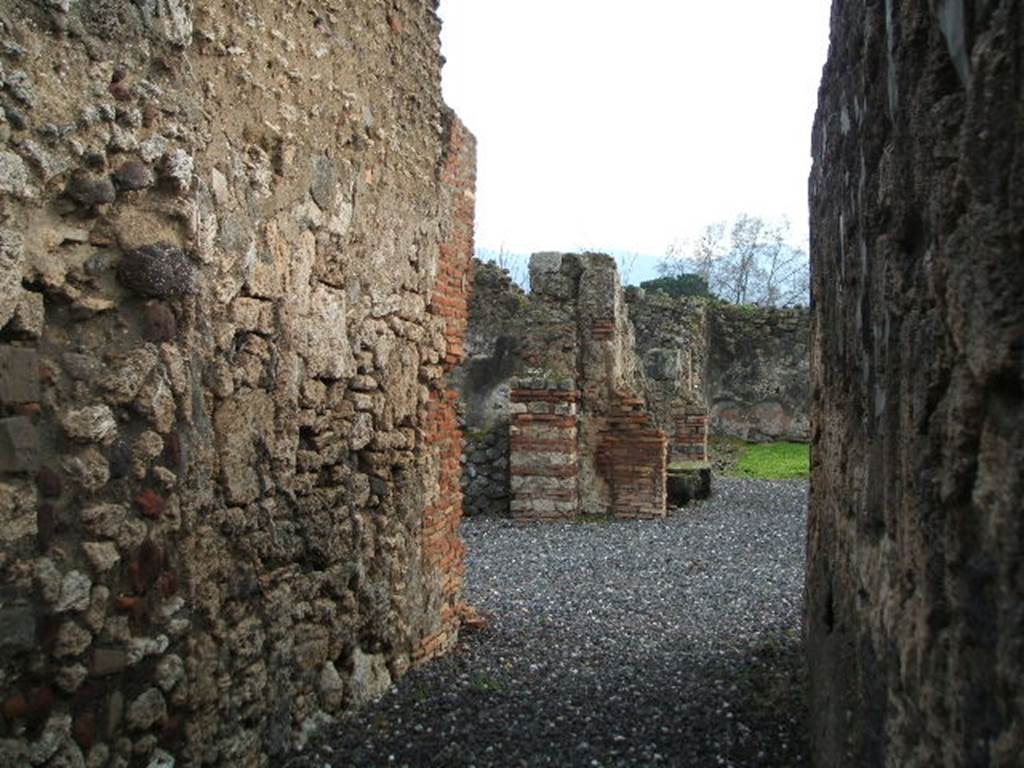
I.3.15 Pompeii. December 2007. Niche for household gods.
According to Boyce –
in the west wall to the right of the entrance above a masonry table was an arched niche (h.0.60, w.0.42, d.0.25, h. above table, 0.30).
Its walls covered with successive layers of stucco, variously painted red, blue and yellow.
He said Fiorelli referred to it as la nicchia dei Lari.
See Boyce G. K., 1937. Corpus of the Lararia of Pompeii. Rome: MAAR 14. (p.24, no.24).

I.3.15 Pompeii. 1935 photograph taken by Tatiana Warscher. Looking towards arched niche in west wall.
See Warscher, T, 1935: Codex Topographicus Pompejanus, Regio I, 3: (no.31), Rome, DAIR, whose copyright it remains.
According to Warscher, quoting Fiorelli,
“On the right of this workshop were the first steps of the stairs that went up to the upper floor, under which was a podium, with furnace in the middle to accommodate a large boiler, which was used as a laundry. Embedded in the wall was the niche for the Lares”.
I.3.20 Pompeii.
Altar, found on right side of peristyle, no longer in situ. (No photo).

I.3.20 Pompeii. December 2007. Looking south along entrance corridor towards atrium and rear of peristyle.
According to Boyce, on the right side of the peristyle stood a small altar, coated with stucco.
On the yellow background, there were painted festoons and masks.
The excavation report called it a lararium. This is no longer in situ.
He gives the reference Bull. Inst., 1869, 242.
See Boyce G. K.,
1937. Corpus of the Lararia of Pompeii.
Rome: MAAR 14. (p. 24, no.25).
I.3.24 Pompeii.
Painting seen at the moment of excavation, south side of garden walkway. (No photo).
According to Boyce, on the south wall of the peristyle was the Lararium painting. He described -
The Genius, holding cornucopia against his left shoulder, poured a libation upon an altar from a patera held in his right.
Beside him stood a Camillus holding a shallow dish.
Opposite the Genius were the tibicen and the popa, the latter leading a pig to sacrifice.
Only the Lar on the right remained.
In the lower zone, a single red and yellow serpent coiled towards an altar.
Nothing now remains of this painting in situ.
See Boyce G. K., 1937. Corpus of the Lararia of Pompeii. Rome: MAAR 14. (p. 24)
See Bull. Inst. 1869, p.239.
Painting seen at the moment of excavation, south side of garden walkway.
See Giacobello, F., 2008. Larari Pompeiani: Iconografia e culto dei Lari in ambito domestico. Milano: LED Edizioni, (p.134, no.6)
Jashemski said the peristyle had a portico on the north and east side supported by three brick columns.
There was a Lararium painted on the south wall of the portico.
Also a crudely executed animal painting, no longer visible, on one corner of the south garden wall.
See Jashemski, W. F., 1993. The Gardens of Pompeii, Volume II: Appendices. New York: Caratzas. (p. 28).
I.3.27 Pompeii.
Fragmentary painting found on one wall of Bakery, no trace remains. (No photo).

I.3.27 Pompeii.
March 2009. North wall of pistrinum or bakery room.
According to
Fiorelli, when excavated the remains of a painted lararium were found somewhere
in this area.
Fiorelli said only
the two serpents approaching the prepared altar remained visible.
See Pappalardo, U., 2001. La
Descrizione di Pompei per Giuseppe Fiorelli (1875). Napoli: Massa Editore. (p. 40)
Boyce said, on one
wall was a fragmentary lararium painting, of which a single Lar, and the
serpents confronted at an altar with offerings, were visible at the time of
excavation.
See Boyce G. K.,
1937. Corpus of the Lararia of Pompeii.
Rome:
MAAR 14. (p. 24, no.27).
I.3.28 Pompeii.
Semi-circular arched niche in south wall.

I.3.28 Pompeii. September 2010. Looking south across counter. Photo courtesy of Drew Baker.
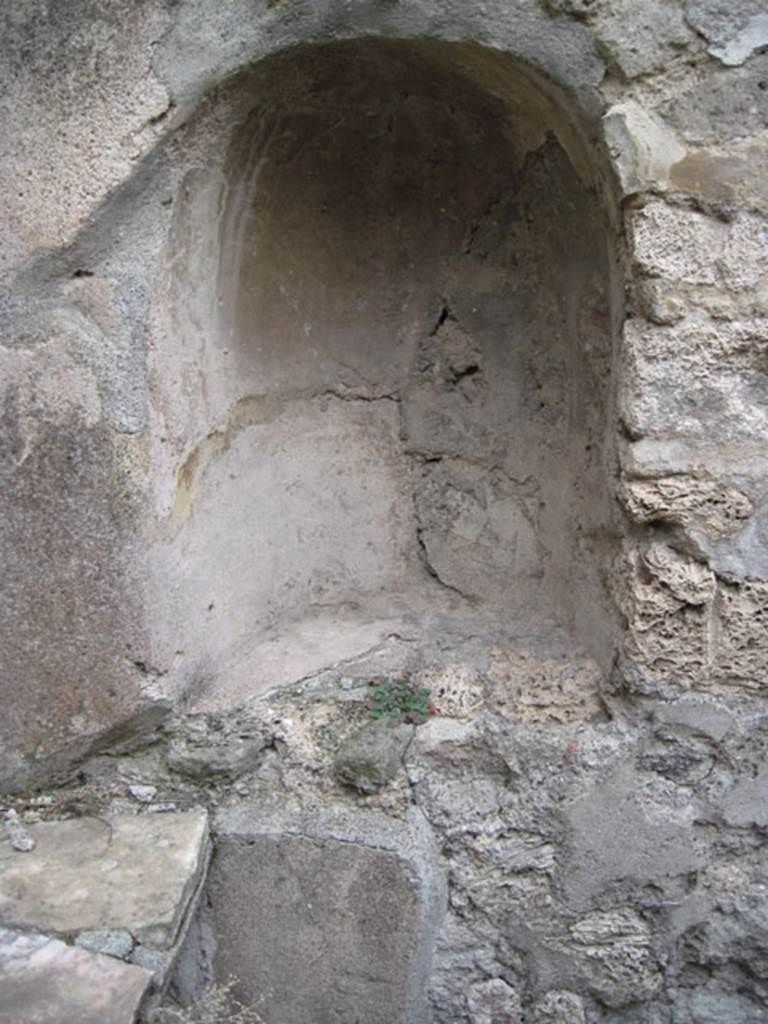
I.3.28 Pompeii. September 2010. Niche in south wall behind counter. Photo courtesy of Drew Baker.
According to Boyce –
In the south wall is a semi-circular arched niche (h.0.57, w.0.40, d.0.27, h. above floor 0.77).
See Boyce G. K., 1937. Corpus
of the Lararia of Pompeii. Rome:
MAAR 14. (p.24, no.28).
I.3.30 Pompeii.
Arched niche with painting, west wall of peristyle.
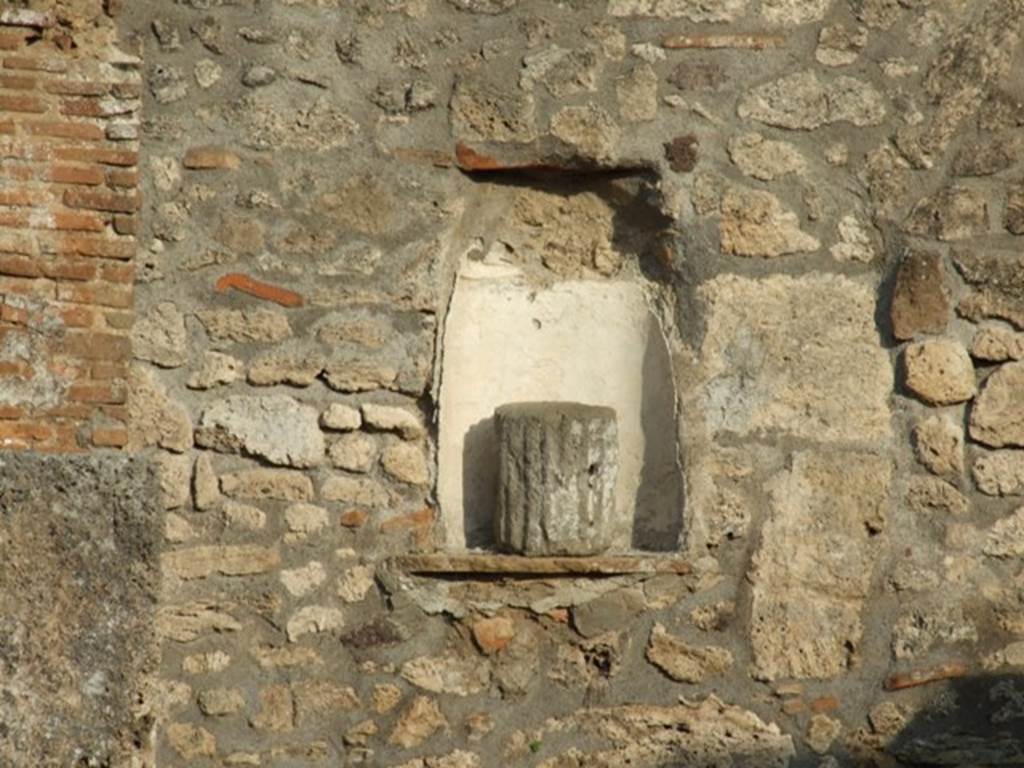
I.3.30 Pompeii. Lararium in peristyle at foot of straight flight of stairs.
Old undated photograph courtesy of the Society of Antiquaries, Fox Collection.
According to Boyce –
in the west wall of the peristyle was an arched niche (h.0.55, w.0.50, d.0.27, h. above floor 1.30).
Its walls were adorned with painted flowers.
On the wall on either side of it, was painted a Lar, 34cms high, holding rhyton and situla.
Below it, there was a single serpent moving towards an altar.
See Boyce G. K., 1937. Corpus
of the Lararia of Pompeii. Rome:
MAAR 14. (p. 24)
See Giacobello,
F., 2008. Larari Pompeiani: Iconografia e culto dei Lari in ambito
domestico. Milano: LED Edizioni, (p.135, no.7)
I.4.5/25 Pompeii.
Arched niche, east wall of
kitchen. (No photo).
Cucina (42),
parete est. Nicchia arcuate.
See Giacobello, F., 2008. Larari Pompeiani: Iconografia e culto dei Lari in ambito domestico. Milano: LED Edizioni, (p.135, no.8)
I.4.9 Pompeii.
Niche, east wall of garden area.

I.4.9 Pompeii.
October 2019. Tablinum h. looking east into courtyard n, with niche in east
wall.
Foto Tobias Busen,
ERC Grant 681269 DÉCOR.
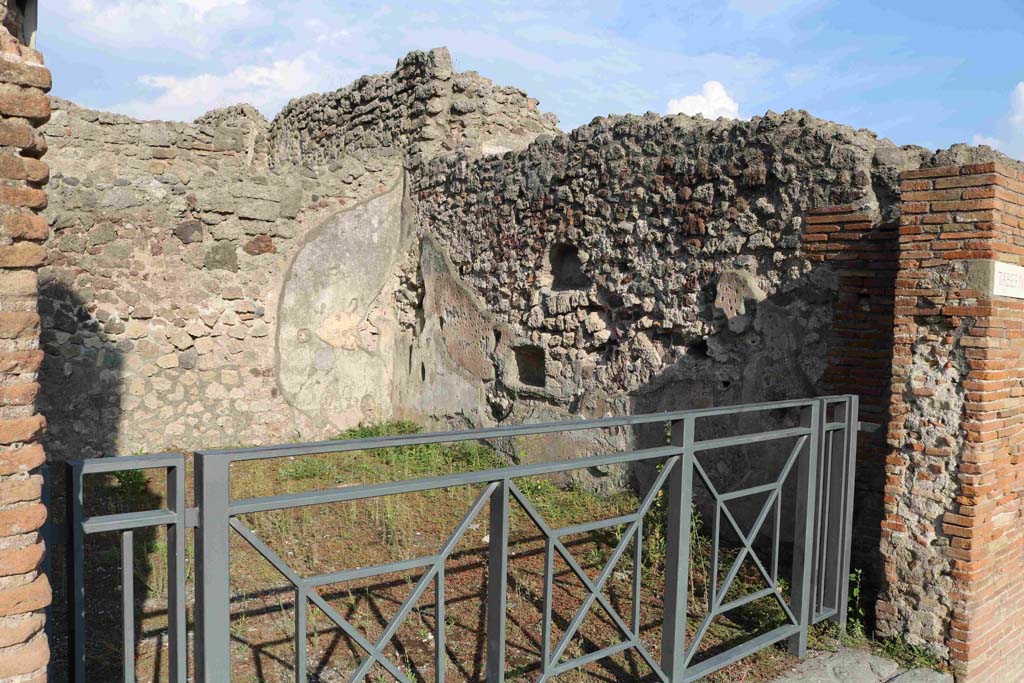
I.4.9 Pompeii. December 2007. Niche on east wall.
According to Boyce –
in the centre of the east wall of the garden area is an
arched niche, (h.0.80, w.0.45, d.0.25, h. above floor 0.80), which Fiorelli
called la nicchia de’ Penati.
See Boyce G. K., 1937. Corpus
of the Lararia of Pompeii. Rome:
MAAR 14. (p. 24, no. 30).
See Giacobello, F., 2008. Larari Pompeiani: Iconografia e culto dei Lari in ambito domestico. Milano: LED Edizioni, (p.252, no.V4)
I.4.11 Pompeii.
Lararium painting on north wall of a rear room, no trace remains. (No photo).
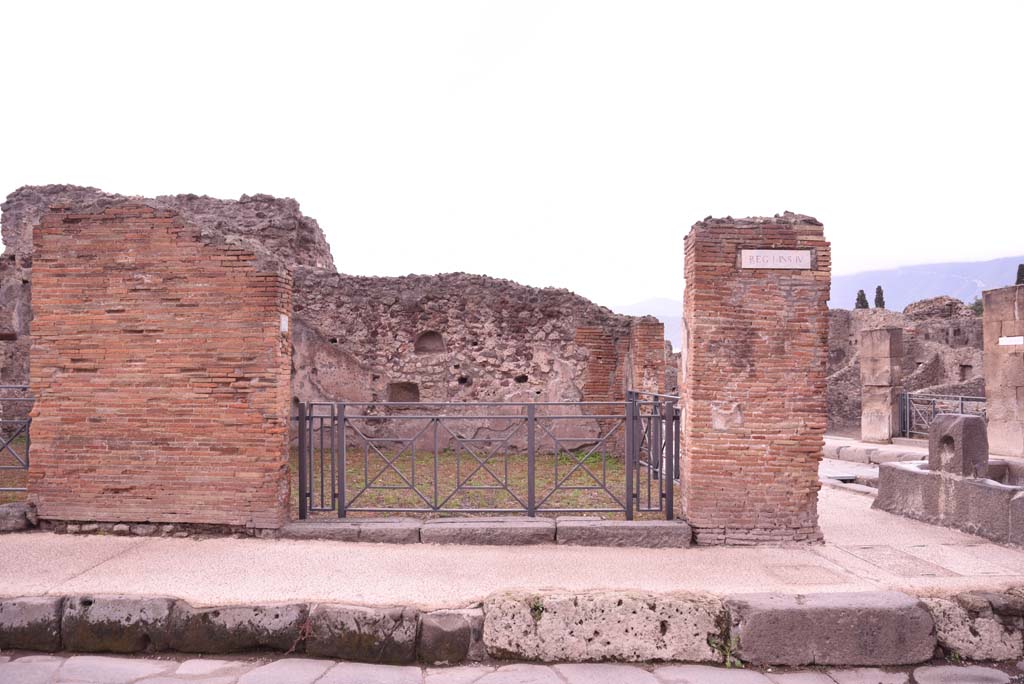
I.4.11 Pompeii, in
centre, with I.4.10, on right. October 2019. Looking east towards entrance
doorways on Via Stabiana.
Foto Tobias Busen,
ERC Grant 681269 DÉCOR.

I.4.11 Pompeii.
October 2019. Looking east along north wall of garden area.
Foto Tobias Busen,
ERC Grant 681269 DÉCOR.
On the north wall of the rear room is a lararium painting (h.1.32, w.1.0): The Genius pours a libation upon an altar; on each side of him stands a Lar; below is the altar with the two serpents. Against the wall below the painting stands a masonry altar.
See Boyce G. K.,
1937. Corpus of the Lararia of Pompeii.
Rome: MAAR 14. (p.25, no.31).
I.4.15/16 Pompeii.
Two niches on south wall.
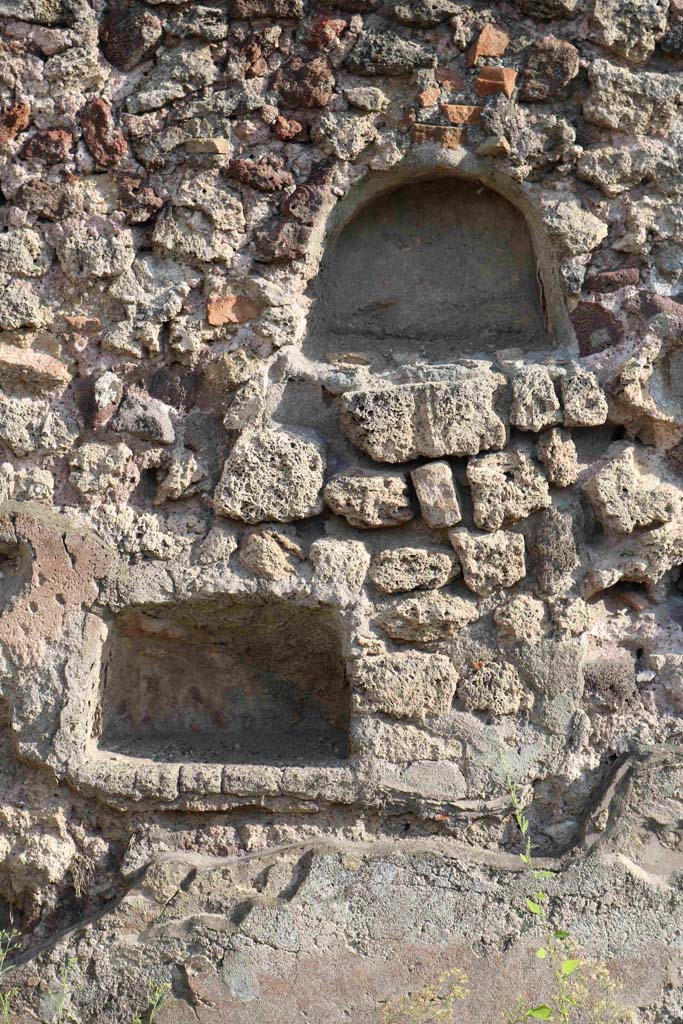
I.4.15 Pompeii. September 2018.
Looking towards south wall with niches, from entrance doorway on Via Stabiana. Photo courtesy of Aude Durand.
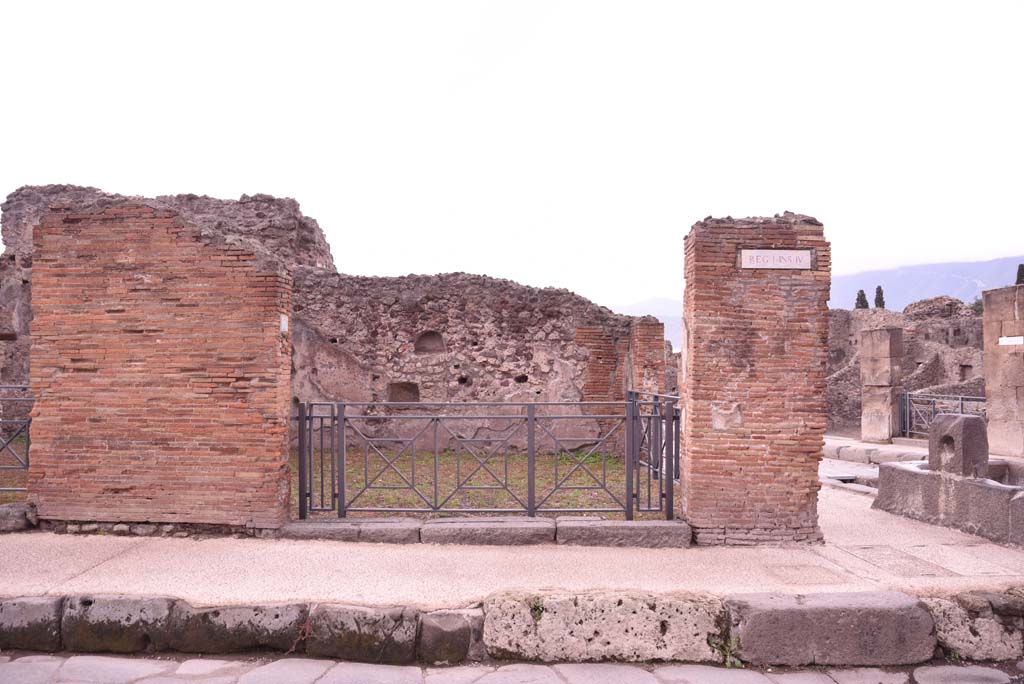
I.4.16 Pompeii.
October 2019. Looking south to entrance doorway from Via dell’Abbondanza.
Foto Tobias Busen,
ERC Grant 681269 DÉCOR.
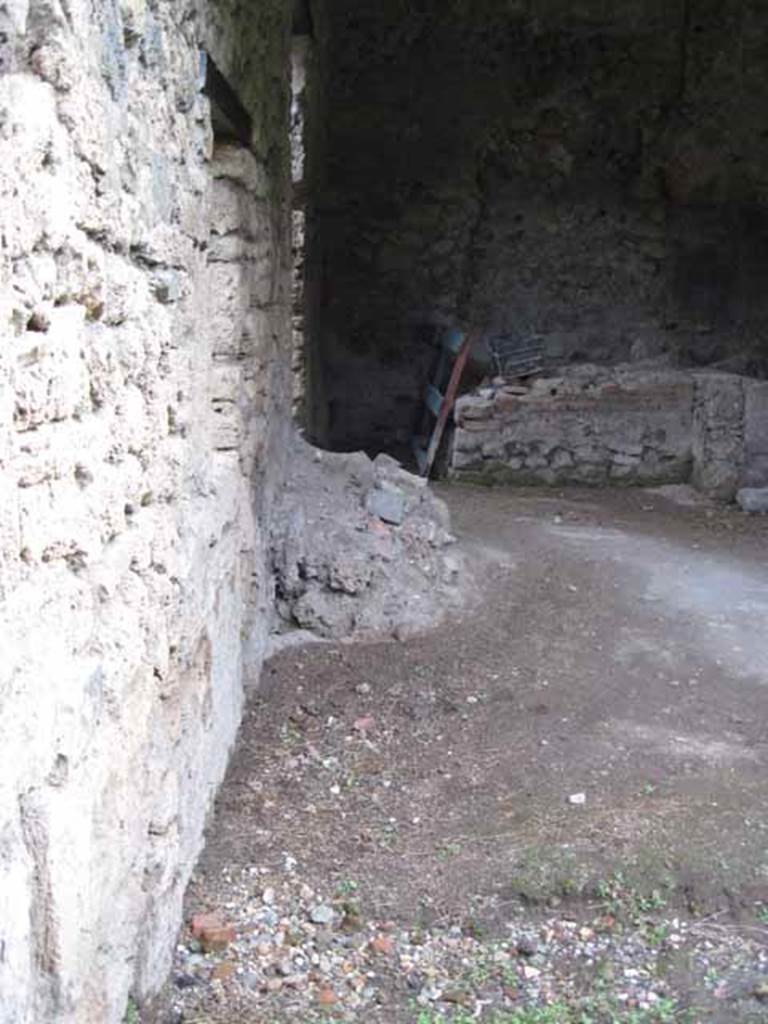
According to Boyce, either or both of these could have been lararia. One is 0.50 higher than the other.
The upper niche (h.0.35, w.0.45, d.0.20), was arched and had its walls coated with red stucco.
The lower niche (h.0.30, w.0.50, d.0.27, h. above floor 0.80) having a rectangular opening combined with a back wall which curved from back to front. Its walls were coated with white stucco decorated with painted red dots, to represent flowers.
See Boyce G. K., 1937. Corpus of the Lararia of Pompeii. Rome: MAAR 14. (p.25, no.32).
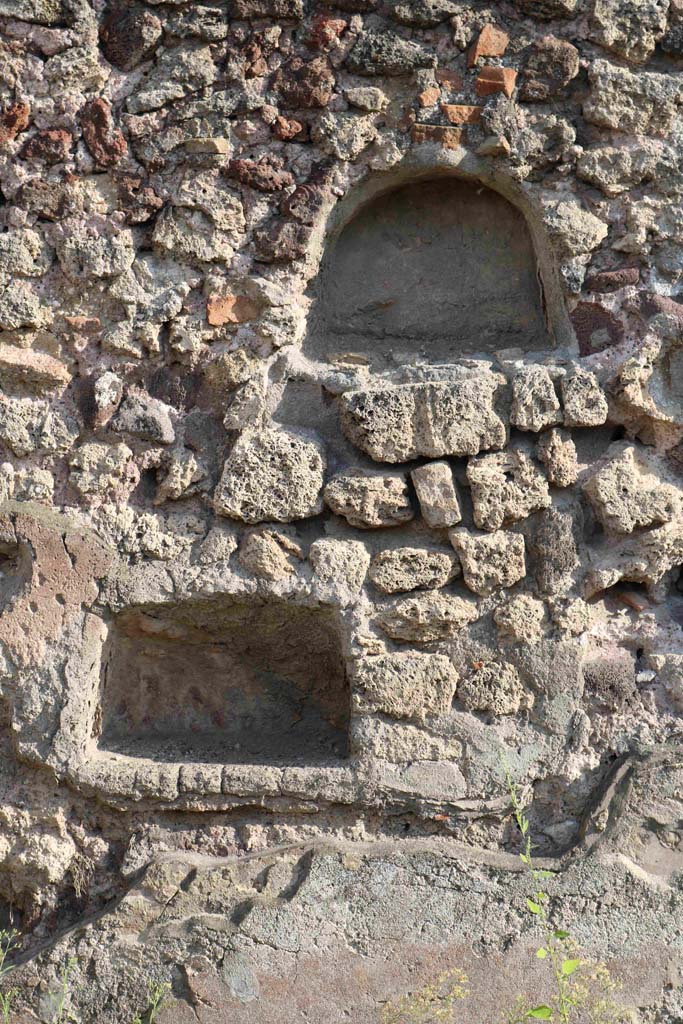
I.4.15/16 Pompeii. September 2018.
Detail of two niches on south wall of shop with two doorways. Photo courtesy of Aude Durand.
I.5.2 Pompeii.
Ruined lararium, masonry podium, with painted aedicula on wall above, but no trace remains.
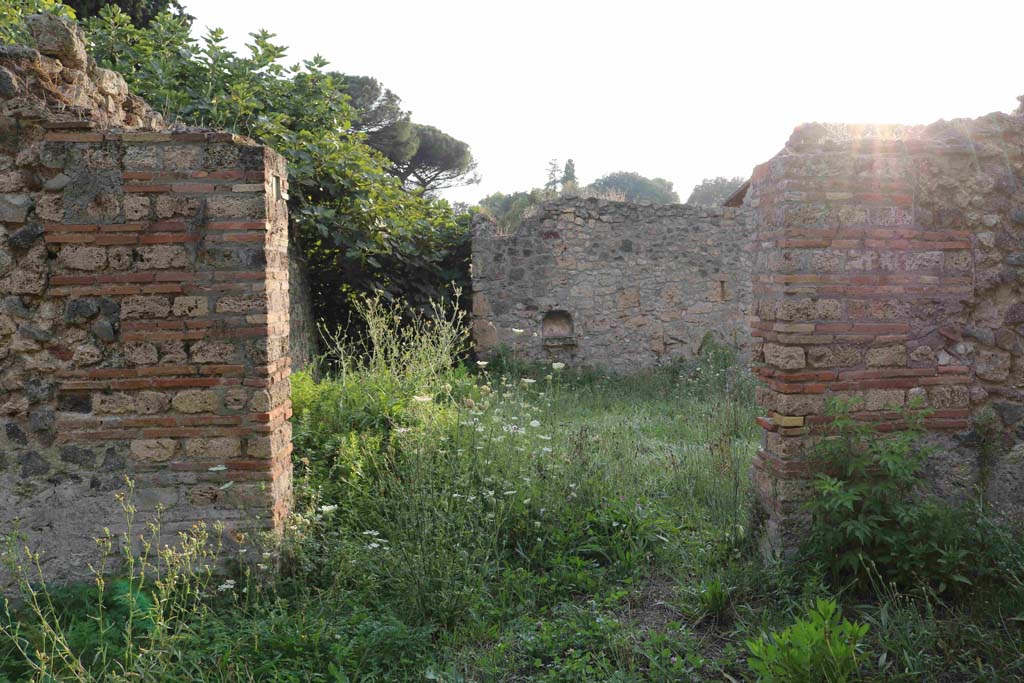
I.5.2 Pompeii. September 2010.
Looking east along north portico of peristyle area, towards feature against the north wall.
Photo courtesy of Drew Baker.
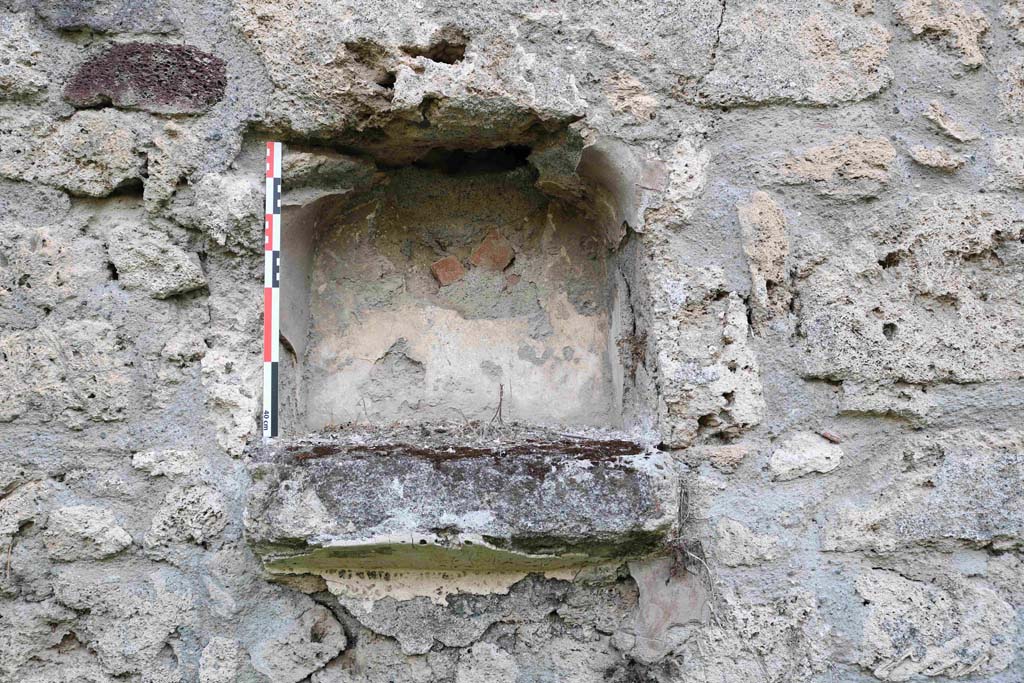
I.5.2 Pompeii. September 2010.
Looking north towards remains of masonry podium of lararium. Photo courtesy of Drew Baker.
According to Boyce, there was a ruined lararium in a room on the north-east side of the peristyle.
It was a solid podium (0.80 by 1.0, h. varies from 0.48 to 0.90) standing against the wall, with its three sides painted in imitation marble veneer.
There was a painted aedicula on the wall above it.
He quotes – Bull. Inst., 1874, 275; Fiorelli, Descr., 451.
See Boyce G. K., 1937. Corpus
of the Lararia of Pompeii. Rome:
MAAR 14. (p.25 no.33).
I.5.3 Pompeii.
Arched niche in west wall.
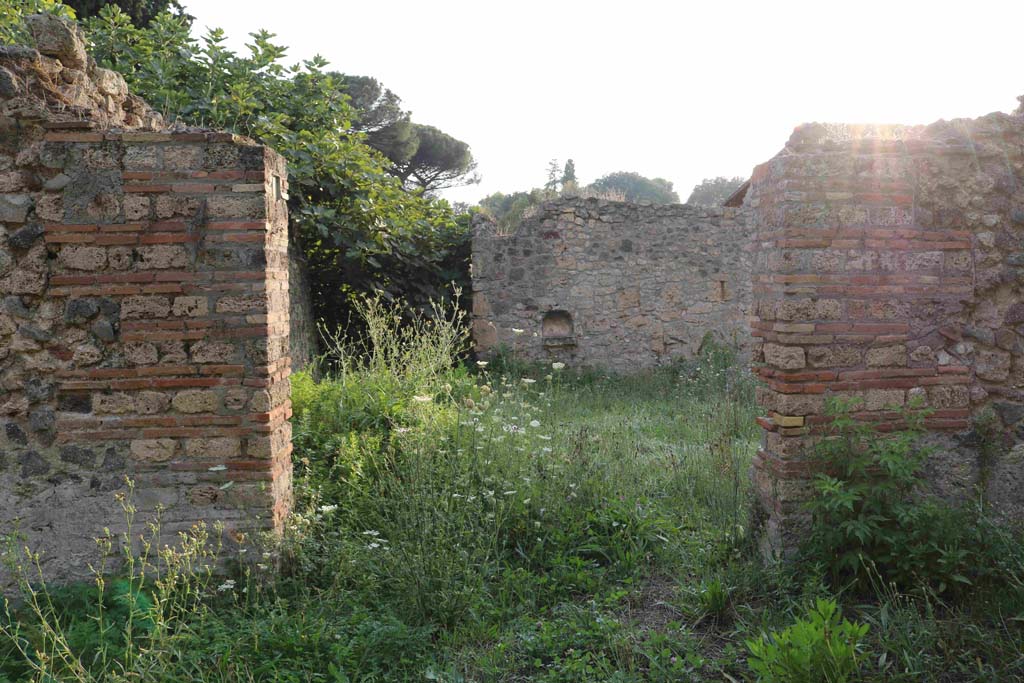
I.5.3 Pompeii. September 2018. Entrance doorway, looking west along south side. Photo courtesy of Aude Durand.
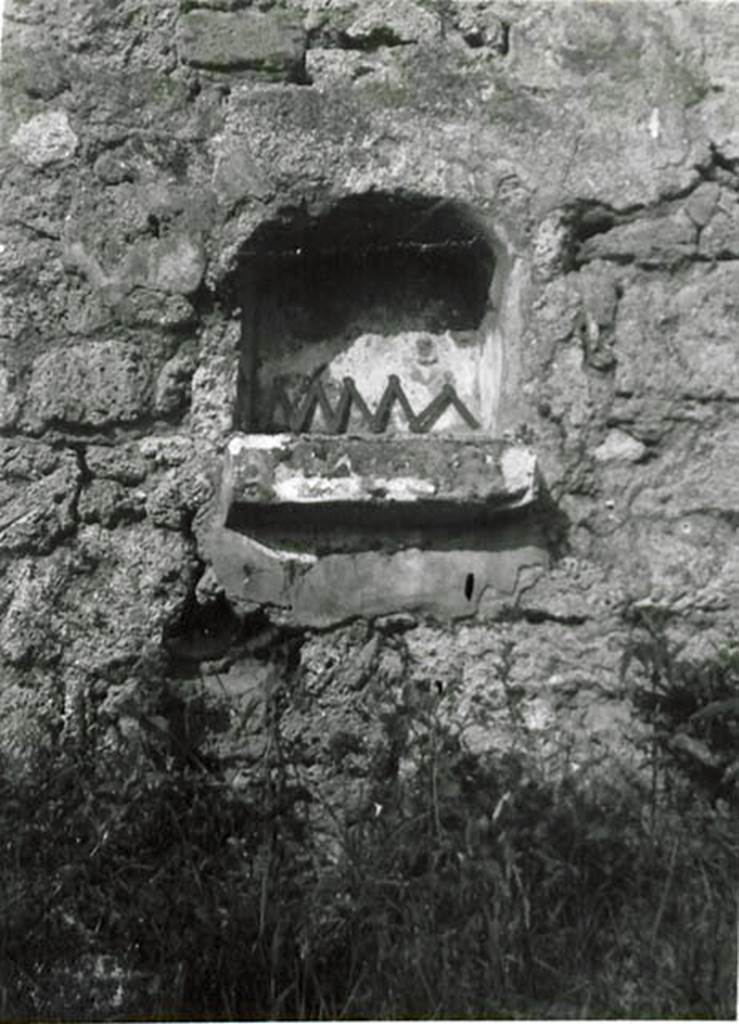
I.5.3 Pompeii. September 2018. Niche in west wall. Photo courtesy of Aude Durand.
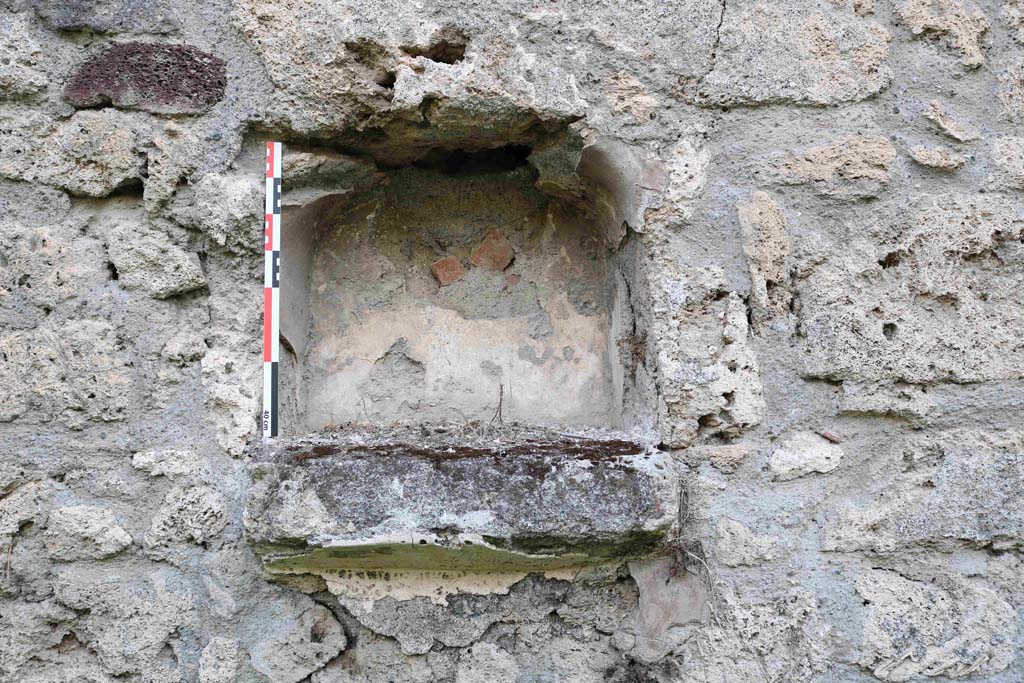
I.5.3 Pompeii. September 2018. Detail of niche in west wall. Photo courtesy of Aude Durand.
Boyce reported that there was an arched niche (h.0.45, w.0.45, d.020, h. above floor 0.80) in the west wall with projecting floor.
See Boyce G. K., 1937. Corpus of the Lararia of Pompeii. Rome: MAAR 14. (p.25, no. 34).
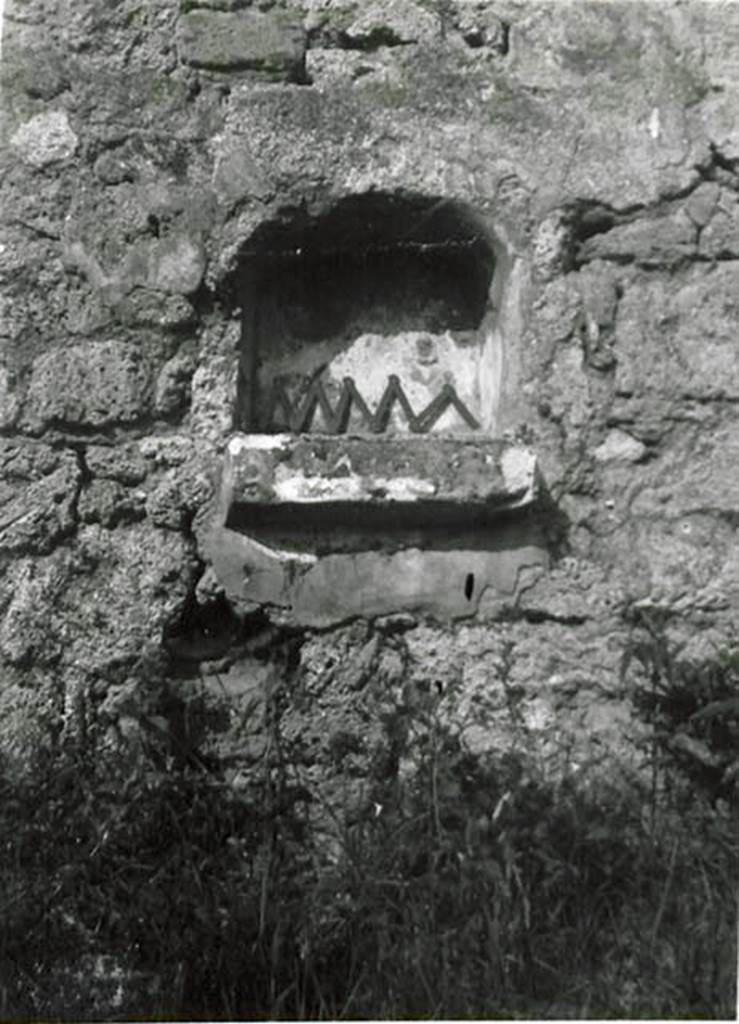
I.5.3 Pompeii. 1936, taken by Tatiana Warscher. Niche in west wall of large open area.
Warscher
described this as “Nicchia dei penati nel muro ovest della stanza “a”.
She also noted
“Del piccolo muro o forse d’una specie d’impluvio che è marcato sulla pianta io
non ho trovato nessuna traccia”
See Warscher T., 1936. Codex Topographicus Pompeianus: Regio I.1, I.5. (no.36), Rome: DAIR, whose copyright it remains.
(translation – Niche for worshipping the household gods
in the west wall of room “a”.
Of the small wall, or perhaps a type of impluvium, that
is marked on the plan, I have not found any trace”.)
Back to household shrines list